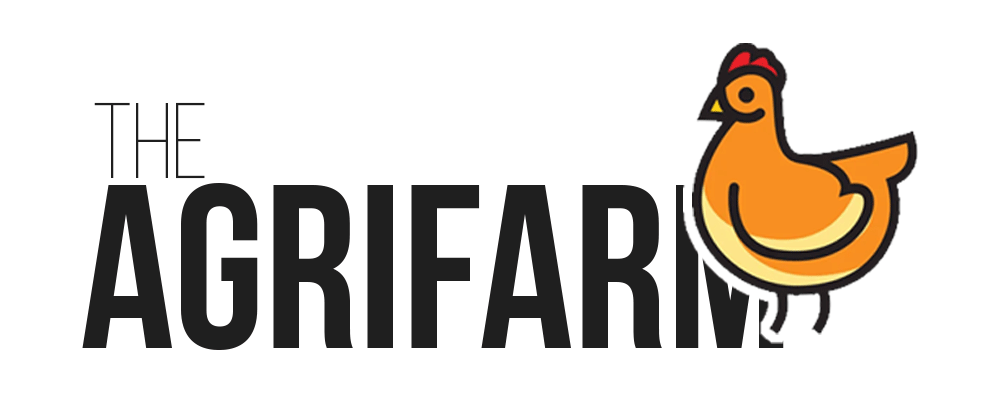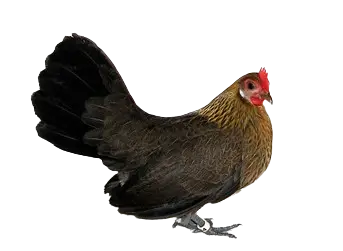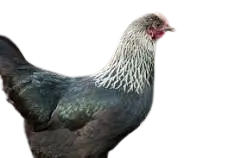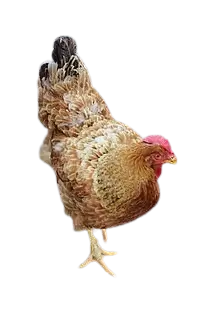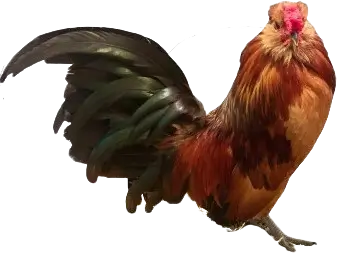Leghorn chicken

The Leghorn chicken is a light chicken breed that originated in the rural parts of Tuscany. “Leghorn” comes from “Livorno,” the port city where the first birds were exported to North America in 1828. They were initially called “Italians,” but their name changed to “Leghorns” in 1865. The Leghorn chicken was brought to Britain from the United States in 1870. British breeders then crossed the Leghorn with the Minorca and the Malay to increase its size, making it more appropriate for use as meat. However, the Leghorn is still a slender bird mainly valued for its egg-laying abilities.
The Leghorn chicken is also known as Livorno or Livornese in Italian and Italian in German. The French Poultry Federation recognizes four types of Leghorn: the American white, the English white, the old type (golden salmon), and the modern type. There is also an autosexing variety called the Cream Legbar, created by crossing the Leghorn with the Barred Plymouth Rock and the Araucana.
Types
The American Poultry Association, the Entente Européenne d’Aviculture et de Cuniculture, and the Poultry Club of Great Britain classify the Leghorn chicken as a Mediterranean breed. The Leghorn is also categorized as a soft-feathered and light breed. There are two types of Leghorn chicken: standard and bantam.
Colors
The Leghorn chicken comes in many color varieties that vary depending on the country and the standard. In Italy, ten color varieties are recognized, including white, black, brown, buff, silver, gold, red, blue, cuckoo, and exchequer. In the United States, twelve color varieties are recognized, including white, black, brown, buff, silver, red, black-tailed red, Columbian, golden ducking, silver ducking, rose comb white, and rose comb brown. The British standard recognizes eighteen color varieties, including white, black, brown, buff, silver, red, black-tailed red, Columbian, golden ducking, silver ducking, Pyle, blue, cuckoo, exchequer, mottled, lavender, create, and coral blue.
The most common and popular Leghorn chicken color is white, which is preferred for commercial egg production. The Leghorn has pure white plumage, a bright red single or rose comb, and yellow legs and beaks. It is known for its hardiness, activity, and prolificacy.
Weight of male and female
The weight of a Leghorn chicken varies depending on its type and color. The standard Leghorn is heavier than the bantam Leghorn, and the colored Leghorn is heavier than the white Leghorn. On average, a male standard Leghorn weighs 2.4-3.4 kg, while a female standard Leghorn weighs 2.0-2.5 kg. On the other hand, a male bantam Leghorn weighs 1 kg, and a female bantam Leghorn weighs 0.9 kg on average.
Annual egg production rate, egg color, and egg weight
The Leghorn is a breed well known for its high egg production rate. These chickens can lay up to 280-320 eggs annually, which is impressive. They lay large to extra-large white eggs that weigh around 55-65 grams. They begin laying eggs at about 4-5 months old and can continue for 5-7 years. Many consumers and markets prefer the white egg color.
Leghorn Chicken Size
The Leghorn chicken is a graceful bird with a slender build, long neck, prominent breasts, and well-rounded body. The cock boasts a large and upright single or rose comb, a long, curved beak, and a long, flowing tail. On the other hand, the hen has a smaller and neater comb, a shorter and straighter beak, and a shorter, more compact tail. The size of the Leghorn chicken varies by type and color, but the average length of a standard Leghorn is about 60-70 cm for males and 50-60 cm for females. Meanwhile, the average length of a bantam Leghorn is roughly 40-50 cm for males and 35-45 cm for females.
Yearly birth rate and life span of Leghorn Chicken
The Leghorn chicken is a highly productive and fertile breed that can produce many chicks every year. The chicken’s yearly birth rate depends on three factors: the number of eggs laid, the hatchability rate, and the survival rate of the chicks. On average, a Leghorn chicken lays about 280-320 eggs per year, with a hatchability rate of 80-90% and a survival rate of 70-80%. Based on these figures, the chicken’s estimated yearly birth rate is 157-206 chicks yearly.
The lifespan of a Leghorn chicken varies depending on its health, care, and environment. This breed is known for its hardiness and adaptability to different climates and conditions. It is also resistant to many diseases and parasites that can affect other breeds. The average lifespan of a Leghorn chicken is between 5-7 years, though some birds can live longer if they are well-cared for and protected.
Breeding hints and tips
The Leghorn chicken breed is easy to raise and breed and can be rewarding. Here are some helpful hints and tips for successful breeding of Leghorn chickens:
1. Choose healthy and productive birds that conform to the breed standard and desired color variety. Avoid inbreeding or crossbreeding with other breeds or varieties.
2. Provide a spacious coop with adequate ventilation, lighting, nesting boxes, roosts, feeders, and waterers. Ensure the coop is predator-proof and weather-proof and has a separate area for the breeding flock.
3. Offer a balanced and nutritious diet that meets the Leghorn chicken’s needs. This should include high-quality poultry feed, fresh water, grit, calcium, vitamins, and minerals. Adjust the diet to the bird’s age, stage, and season.
4. Create a suitable and stimulating environment that allows the Leghorn chicken to express its natural behavior and instincts. The environment should include a large and secure run with grass, plants, dust baths, perches, and toys, and it should be free of stress, noise, and disturbance.
5. Regularly monitor the health and performance of the Leghorn chicken and take preventive and corrective measures when needed. Assess the bird’s health and performance by observing its appearance, behavior, appetite, weight, egg production, and quality. Vaccinate, deworm and treat the chicken for any diseases or parasites that may affect it.
6. Collect and store the eggs carefully and properly for hatching. Collect eggs daily and store them in a cool, dry place with a constant temperature and humidity. Turn and candle the eggs periodically to check their fertility and viability. Incubate the eggs within 7–10 days of laying, using either a broody hen or an artificial incubator.
7. Hatch and raise the chicks with care and attention. Hatch the chicks in a clean, warm place with adequate ventilation, lighting, and security. Provide a suitable and hygienic brooder with a heat source, bedding, feeders, and waterers. Feed the chicks a high-protein starter feed, fresh water, and grit. Vaccinate, deworm and treat the chicks for any diseases or parasites that may affect them.
8. Select and cull the birds according to the breeding goals and objectives based on their growth.
General Characteristics
The Leghorn chicken is a breed that boasts numerous positive features and benefits. Here are some of its general characteristics with their respective qualities:
Egg production
The Leghorn chicken is an exceptional egg layer that can produce up to 280-320 large white eggs annually. It is also highly efficient at converting feed into eggs, making it an economical and profitable choice for commercial and backyard egg production.
Temperament
The Leghorn chicken is an active and alert breed that enjoys roaming and foraging. It is also intelligent and curious and can be trained to perform tricks and tasks. However, the Leghorn chicken is not very friendly or docile, and it is not aggressive or noisy either. Therefore, it is best suited for experienced and confident owners who can handle its independent and flighty nature.
Appearance
The Leghorn chicken is a striking and elegant breed with a graceful and slender body, a long, curved neck, a prominent, upright comb, and a long, flowing tail. Its many color varieties can add diversity and charm to any flock. The Leghorn chicken is a breed that can catch anyone’s eye with its attractive and eye-catching appearance.
Adaptability
The Leghorn chicken is a hardy and resilient breed that can adapt to various climates and conditions. It can withstand heat and cold and thrive in confinement and free-range environments. The Leghorn chicken is also resistant to many diseases and parasites that affect other breeds. It is a breed that can survive and thrive in any environment.
